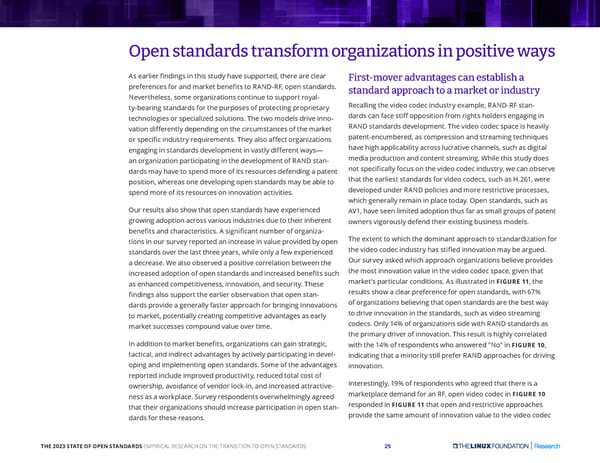Open standards transform organizations in positive ways As earlier findings in this study have supported, there are clear First-mover advantages can establish a preferences for and market benefits to RAND-RF, open standards. standard approach to a market or industry Nevertheless, some organizations continue to support royal- ty-bearing standards for the purposes of protecting proprietary Recalling the video codec industry example, RAND-RF stan- technologies or specialized solutions. The two models drive inno- dards can face stiff opposition from rights holders engaging in vation differently depending on the circumstances of the market RAND standards development. The video codec space is heavily or specific industry requirements. They also affect organizations patent-encumbered, as compression and streaming techniques engaging in standards development in vastly different ways— have high applicability across lucrative channels, such as digital an organization participating in the development of RAND stan- media production and content streaming. While this study does dards may have to spend more of its resources defending a patent not specifically focus on the video codec industry, we can observe position, whereas one developing open standards may be able to that the earliest standards for video codecs, such as H.261, were spend more of its resources on innovation activities. developed under RAND policies and more restrictive processes, which generally remain in place today. Open standards, such as Our results also show that open standards have experienced AV1, have seen limited adoption thus far as small groups of patent growing adoption across various industries due to their inherent owners vigorously defend their existing business models. benefits and characteristics. A significant number of organiza- tions in our survey reported an increase in value provided by open The extent to which the dominant approach to standardization for standards over the last three years, while only a few experienced the video codec industry has stifled innovation may be argued. a decrease. We also observed a positive correlation between the Our survey asked which approach organizations believe provides increased adoption of open standards and increased benefits such the most innovation value in the video codec space, given that FIGURE 11, the as enhanced competitiveness, innovation, and security. These market’s particular conditions. As illustrated in findings also support the earlier observation that open stan- results show a clear preference for open standards, with 67% dards provide a generally faster approach for bringing innovations of organizations believing that open standards are the best way to market, potentially creating competitive advantages as early to drive innovation in the standards, such as video streaming market successes compound value over time. codecs. Only 14% of organizations side with RAND standards as the primary driver of innovation. This result is highly correlated In addition to market benefits, organizations can gain strategic, FIGURE 10, with the 14% of respondents who answered "No" in tactical, and indirect advantages by actively participating in devel- indicating that a minority still prefer RAND approaches for driving oping and implementing open standards. Some of the advantages innovation. reported include improved productivity, reduced total cost of ownership, avoidance of vendor lock-in, and increased attractive- Interestingly, 19% of respondents who agreed that there is a FIGURE 10 ness as a workplace. Survey respondents overwhelmingly agreed marketplace demand for an RF, open video codec in FIGURE 11 that open and restrictive approaches that their organizations should increase participation in open stan- responded in dards for these reasons. provide the same amount of innovation value to the video codec THE 2023 STATE OF OPEN STANDARDS EMPIRICAL RESEARCH ON THE TRANSITION TO OPEN STANDARDS 25
 The 2023 State of Open Standards Page 24 Page 26
The 2023 State of Open Standards Page 24 Page 26